Content
- 1 How to grow onions in water: rules for a good harvest
- 2 How to grow green onions in water at home
- 3 Preparing onions for forcing in water
- 4 Accessories for forcing green onions in water
- 5 Top dressing options for forcing green onions in water
- 6 Preparing onions for forcing in water
- 7 Accessories for forcing green onions in water
- 8 Top dressing options for forcing green onions in water
- 9 What types of onions can be grown on a windowsill?
- 10 Instructions for growing onions on a windowsill
- 11 How to care for onions after planting - advice from gardeners
- 12 Growing onions in water - the original way
Onion greens, rich in vitamins and minerals, can be grown in indoor conditions in different ways, for example, water.
Knowing how to grow onions in water at home will give you a spicy green feather year-round for use in salads and other dishes. We will learn how the water technology of obtaining home greens differs, so that, by growing it, to strengthen the immune system at any time of the year and not to know colds.
How to grow onions in water: rules for a good harvest
To grow a good harvest of onion greens, it is important to follow a few rules:
- Dishes for distillation should be treated with a manganese solution so that the onion does not hurt or rot.
- The bulbs can be immersed in water so that the water only touches the bottom with the roots.
If the onion is completely submerged in water, it will soon begin to rot.
- Before the roots grow back, we remove the container in a cool place, changing the water daily, in the mornings and evenings. As soon as the feather begins to grow back, we change the water once a day.
When feeding, when fertilizers dissolve in water, we change it every 7 days, otherwise the plants do not have time to absorb nutrients.
- Occasionally we rinse the roots in running water and remove the onions from the jars for three hours so that the roots do not rot.
For continuous production of green feathers, add new bowls a couple of weeks after the previous batch has been "planted".

How to grow green onions in water at home
If you don't feel like messing around with containers and soil, and prefer cleaner ways to get onion greens, here's how to plant onions in water at home.
Preparing the bulbs
For forcing greens in water conditions, we use bulbs with a diameter of about 4 cm, not touched by disease and mechanical damage (the size should be approximately the same).
We prepare the onions for planting in this way:
- We cut the planting material to the base.
- We stand for 20 minutes. in hot water (50 degrees) with the addition of potassium permanganate.
- We hold for 10 minutes. in cold water - for hardening, and peel off the husk.
Having prepared the onion, we will learn how to grow it in water in a room environment.
Planting feather bulbs in water
Forcing onions by water is usually done in glass jars, deep bowls, or other wide-necked containers. Alternatively, you can use plastic food containers.
To prevent the onion from rotting, we do the following:
- We take thick cardboard according to the size of the container.
- We cut holes slightly less than the diameter of the planting material.
- Pour water into a bowl.
- Cover the container with cardboard and insert the onions into the holes so that only the root part touches the water.
If you want to know how to plant onions at home in water in an ordinary plate, pour some settled or filtered water into it (room temperature), and put several onions there so that they are immersed in the liquid only a quarter.
By planting the onions in water, we will get the first harvest of green feathers after a couple of weeks. By that time, the height of the feather will reach about 15 cm.
How to speed up forcing onions in water
To know how to quickly grow green onions in water at home and get as much greens as possible, we apply fertilizing with the help of mineral fertilizers.

Fertilization methods for green onions:
- We feed the plants with a solution of a liter of water and 2 teaspoons of complex fertilizers.
- We fertilize the "planting" with a nutrient solution by dissolving potassium chloride (1.5 g), ammonium nitrate (1.5 g) and superphosphate (2 g) in a liter of water.
- We feed the onion by dissolving wood ash in a liter of water - 5 g.
Add nutrient solutions to the water when the roots and green feather appear, but not before.
So, you have learned how to grow onions at home in water on your own, without unnecessary hassle and waste. Try this method of obtaining vitamin greens, and grow aromatic spicy - spicy greens at home all year round!
We all remember very well the slender rows of mayonnaise jars with onions that "decorated" the windows of our grandmothers all winter.
Indeed, for forcing onions on greens, it is not at all necessary to tinker with the ground and force your windowsill with bowls or boxes.
For those who do not want to "breed mud", there is a "cleaner" way to grow green onions - in water.
Preparing onions for forcing in water
As with forcing onion feathers in the ground, you must first select undamaged bulbs, preferably the same size, approximately 3-4 centimeters in diameter.
 Selected bulbs are cut to the base, immersed in hot (50-52 ° C) water, ash or potassium permanganate solution for 20 minutes.
Selected bulbs are cut to the base, immersed in hot (50-52 ° C) water, ash or potassium permanganate solution for 20 minutes.
Then they are immersed in cold water, after which they are completely cleaned of husks (which a good summer resident will collect, dry and store until spring) and only after that the onions are "planted" in jars, cups, glasses, bottles, plates, trays, containers with slots or special "germinators".
Accessories for forcing green onions in water
Most often, glass or tin cans, cups, glasses or bottles with a wide neck are used as containers with water. Water is poured into them, an onion is placed on top and it's done, nothing complicated.
Jars, glasses and cups are not convenient only because the bulbs in them very much rot. This is easy to avoid. Insert the onion into a clean, but no longer desired sock, fill the jar with water a third and dip the sock into the water. The water will rise up the toe and moisturize the bulb and then its roots.
If there is no free glassware in the house, you can adapt any containers for forcing onions, for example, plastic boxes in which salads are laid out in supermarkets. According to the size of each box, you need to take a sheet of thick cardboard and cut holes in it along the diameter of the onion. Then pour water into the container, cover with cardboard, and insert the onions into the holes so that they barely touch the water.
Alternatively, you can grow green onions in a regular bowl. A small amount of settled water at room temperature is poured into a plate and the bulbs are placed tightly to each other, trying to keep them upright. The water should cover the bulbs by no more than a quarter.
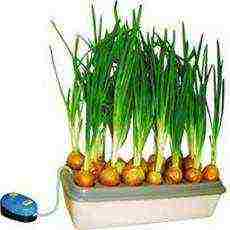 There are also special devices - onion sprouters. They are built on the principle of "hydroponics": the bulbs are inserted into the holes intended for them, water is poured into the container, and a water suspension is created between the bulbs and the water using a compressor. The bulbs hardly come into contact with water, do not rot, but give roots and knock out the feather much faster.
There are also special devices - onion sprouters. They are built on the principle of "hydroponics": the bulbs are inserted into the holes intended for them, water is poured into the container, and a water suspension is created between the bulbs and the water using a compressor. The bulbs hardly come into contact with water, do not rot, but give roots and knock out the feather much faster.
Growing onions in water, after two weeks you will get green feathers 12-15 centimeters long. Want to get your first crop faster and get the most out of each bulb? Then you have to feed the onion with mineral fertilizers.
Top dressing options for forcing green onions in water
Fertilizers are applied to the water when the bulbs have already taken root and the green mass has begun to grow.
Finally, remember a few simple rules for growing onions for herbs in water:
- It is better to disinfect the container for forcing green onions, whether it is a jar or a plate, with a pink solution of potassium permanganate.
- The water should only lightly touch the bottom of the bulb. Do not immerse the whole bulbs in water, they will rot.
- Before the roots grow, keep the dishes with the bulbs in a cool place.
- Until the roots appear, the water in the containers must be changed twice a day - in the morning and in the evening. When the greens are growing, change the water every 24 hours. If you are feeding onions by dissolving fertilizers in water, change the liquid once a week.
- Rinse the roots and utensils from time to time under running water.
- To prevent the bulbs from rotting, periodically remove them from the containers with water and leave them "free" for three to four hours.
- Put each batch of onions for distillation two weeks after the previous one, and then fresh herbs will be on your table continuously.
We wish you success and big harvests!
Please rate the article. We tried very hard:
(
estimates, average:
out of 5)
SHARE COUNTRY TIPS AND GARDEN TIPS WITH YOUR FRIENDS: WE RECOMMEND TO READ:
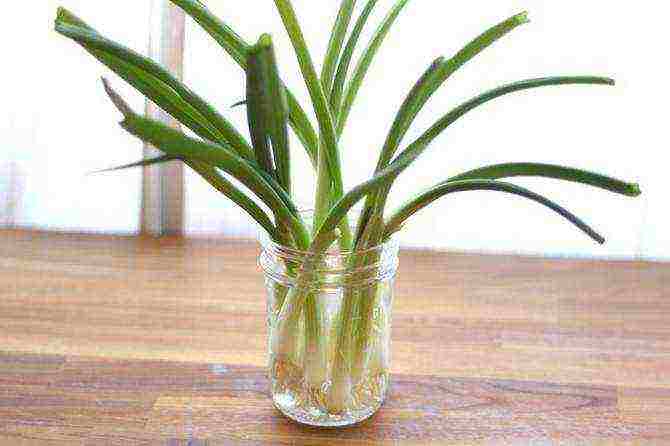
How nice to see green onions on the dinner table in winter. Many remember from childhood that there were small glass jars of water on the windowsills, in which the bulb took root and presented with green feathers. It turns out that it is not necessary to arrange a garden in your kitchen from boxes of earth. Everyone can grow green onions in a more convenient way - in water. To do this, you must follow very simple rules.
Preparing onions for forcing in water
Bulbs for forcing feathers must be selected without damage and of approximately the same size. It is more convenient to use small bulbs, about five centimeters in diameter. Each onion must be cut off the top and then placed in water heated to fifty degrees (or a solution of potassium permanganate) for about twenty minutes.
Having sustained the allotted time in the liquid, the bulbs are immersed in chilled water, and then freed from the husk. The bulbs prepared in this way can be planted in any small containers with water for germinating the feathers.
Accessories for forcing green onions in water
Almost any dish that is at hand is suitable for growing green onions. These are a variety of jars, glasses, cups, cut plastic bottles and plastic containers. All you need to do is pour water into a bowl and lower the onion there. True, not every prepared container will be convenient. Most of them often serve as a place for bulb rot.
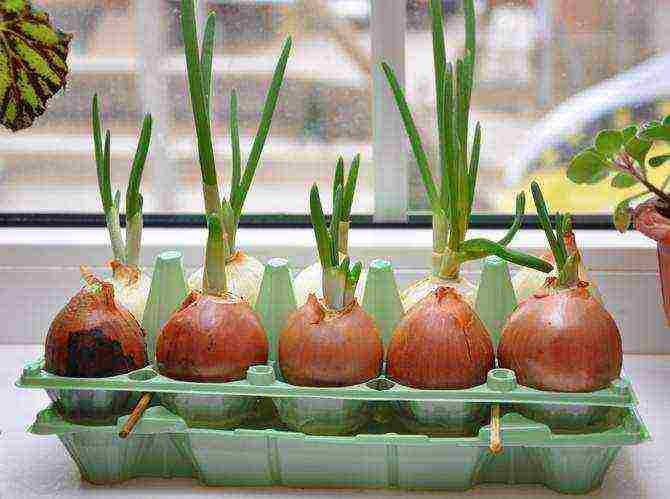
To avoid the formation of rot, you can use the materials at hand. You need to take a clean piece of cloth (or a clean, but not wearable sock), place it in the middle of the onion. Then lower it together with the cloth into a container about one third full of water. The water will be absorbed into the fabric and rise up to the bulb itself. Being constantly in a humid environment, the vegetable will very soon take root and feathers.
For growing onions, you can use various larger plastic containers, which can hold about a dozen bulbs at once. You can use thick cardboard as a cover. It is taken to fit around the perimeter of the box or container. For each onion, a round hole is cut on a piece of cardboard. Water must be poured in such an amount that the bulbs inserted into the holes only slightly come into contact with the liquid.
If there is no utensil in the house that can be used to grow onions, then you can get by with an ordinary dinner plate. The bulbs on it should stand, tightly pressed against each other, and be in a minimum amount of water.
There are also more modern methods and devices for sprouting onions. Such devices work on the basis of the principle of hydroponics, that is, growing plants without soil.The basic principle is the same - a container of water and a bow inserted into special holes. Only in this device is a compressor connected, which forms a water suspension. In such conditions, the roots and feathers grow much faster, and there is no danger of decay.
The first harvest of green onions can be tasted for ten to fifteen days. To speed up the plant's growth a little more, try using mineral fertilizers.
Top dressing options for forcing green onions in water
As soon as small roots have appeared and the first onion feathers have cut through, you can use top dressing, which is added directly to the water. Previously, in a separate container, you need to prepare a solution that will serve as a fertilizer. One liter of settled water at room temperature is taken as a basis, to which you can add two teaspoons of any mineral dressing (or five grams of wood ash).

Remember the basic rules for growing onions in water:
- The container chosen for planting onions must be pre-treated with a disinfectant solution (for example, potassium permanganate)
- For the period of germination of the root system, it is better to put the container with onions in a cool place.
- Remember to change the water twice a day before roots appear.
- Only the lower part of the bow should be in contact with water.
- Occasionally it is useful to rinse the onion roots and container under running water.
Following these simple recommendations, you can easily grow onions in water.
Growing onions at home is available to absolutely everyone - it is a fairly simple process that does not require knowledge and experience. One has only to try, and you can enjoy delicious and healthy green onion feathers throughout the year, and completely free of charge.
What types of onions can be grown on a windowsill?
In addition to the well-known onions at home, you can grow chives, shallots, slugs and multi-tiered onions. Now we will look at how to grow onions at home and what you need to consider when choosing one or another variety.
- Shallots are popular for producing nearly twice as many feathers as onions and growing about a week earlier. The only feature of this species is the obligatory cutting 30-35 days after planting. If you forget about this, there is a great risk of losing your harvest. In addition, it is advisable to plant shallots no earlier than mid-February, otherwise the plant will germinate very slowly. The bulb you just cut the feathers from can be reused: cut it across, plant it again and re-harvest after a short time.
- The advantage of chives is that arrows of this type grow several times faster than onions - they will be ready for consumption literally a week after planting. After cutting, the arrows grow back within two weeks.
- The onion is well known. Its main advantage is its high growth rate. True, the feather coarsens over time, and therefore you need to cut it off in a maximum of a month.
- Multi-tiered onions yield more yields than onions, while having very delicate feathers that are ready for cutting on average 25 days after planting.
- The main difference between the slime onion and other species is that the leaves of this variety remain juicy and tender throughout the growing season. Feathers are cut at a height of up to 25 cm.
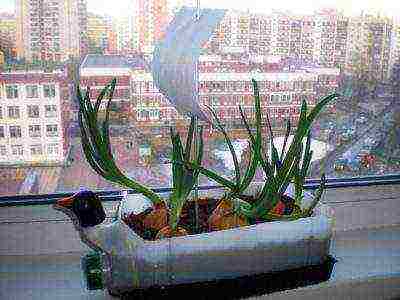
Instructions for growing onions on a windowsill
The most effective and simple way to grow onions at home is the method of forcing on a feather (through sprouting a root crop). It is better to take the bulbs of the same size (no more than 3 cm), they must be healthy and strong, without damage. We place the selected root vegetables in a container with warm water (up to 40 degrees) and put them near the radiator for a day.
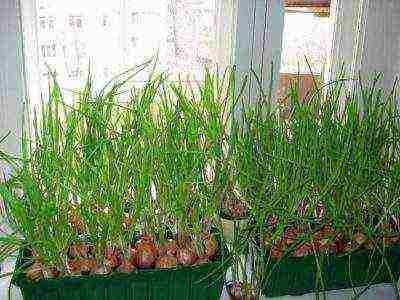
After that, examine the bulbs again, remove the top layer of husk and cut off the top 1.5 cm.For growing, take any wooden box or plastic container up to 10 cm deep. It is best to prepare several containers so that you can grow the plant using conveyor methods - in this case, you will not need to wait for the next portion of onions to sprout.

Use ordinary garden soil or substrate (fine gravel, sand or expanded clay) as a soil for planting. The substrate is washed twice before use. The first time - in a hot solution of potassium permanganate, the second - in running clean water. We fill the container with soil to a height of 4 cm. Lower the prepared roots into the soil every 2 cm, trying to keep them in an upright position. Do not deeply bury the roots in the ground so that they do not rot.
How to care for onions after planting - advice from gardeners
To grow a good harvest, you need to properly care for the seedlings after planting. So, the container with plantings must be placed in a warm place (the temperature must exceed +25 ° C). When the first stems appear, transfer the container to a windowsill. In this case, it is advisable to choose windows facing south or southwest. If there is not enough sunlight for the plants, try illuminating containers with seedlings with fluorescent lamps.
Only in the case of normal lighting will green feathers be able to accumulate useful trace elements, acquiring a rich aroma and taste.

Water the planted root crops 3 times a week with exceptionally warm water. The main thing is that the water is constantly just below the surface of the soil, the soil should not dry out, because during the growth period, onions need a lot of water. Do not cut off the first arrows that have grown, this may slow down the growth of green mass. It is advisable to cut off the feathers 20-25 days after planting, while the extreme arrows are first cut off and only then the central ones. In order for the green mass to grow constantly, the interval between planting onions in boxes should be 1.5 weeks.
Growing onions in water - the original way
There is another way to grow onions on your windowsill or balcony - to use not soil, but water for planting. True, this method is quite laborious and requires certain skills. To grow plants in this way, take large and already sprouted root crops (from 4 cm or more) and several deep containers. In order for the roots to grow and not rot, they must be placed in the selected container so that only the lower part of the bulb with regrown roots is in the water.
To keep the root vegetable in this position, use cardboard with a cut out hole - cover the glass with the structure and place the onion in the hole. Thanks to this, the root crop will confidently hold in the required position. The bulb is kept in a glass of water for 3 to 5 days, after which the container is moved to the windowsill.
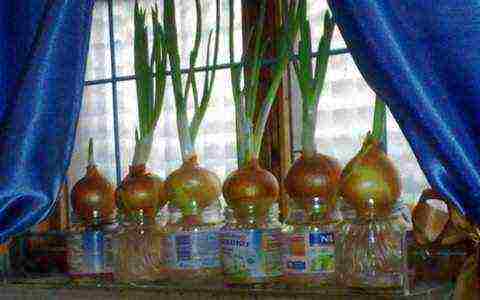
Before the roots form, the water in the glass or plate must be changed twice a day, when the feathers begin to grow - once a day. In this case, it is necessary to rinse the roots and dishes themselves under a stream of clean water. By the way, it is advisable to take water for growing bulbs either bottled or settled for a day.
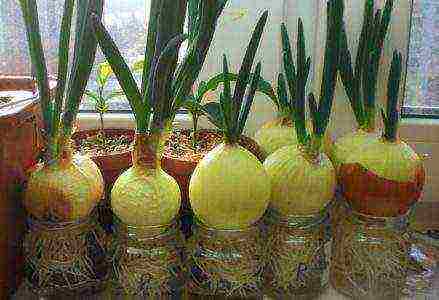
The temperature in the room where the containers with onions will be located should not exceed 22 ° C - otherwise, the onion arrows will be thin and faded. A similar temperature should be at home when growing radishes. Feathers that have grown above 20 cm are cut off, the bulbs themselves are thrown away - they are not suitable for replanting. By the way, it is undesirable to fertilize onions - for normal growth it will have enough sunlight and water. Well, now you know how to plant onions at home and how to grow them so that you can enjoy healthy foods all winter in a row. We hope our tips will help you with this.


